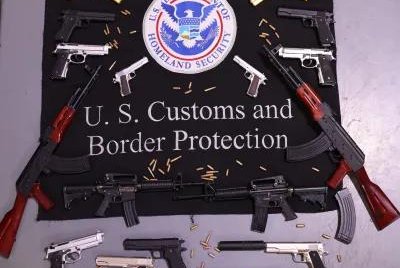“Replica firearms — even though not always functional — can be easily mistaken for genuine weapons by the public and law enforcement. Such misidentification can lead to tragic outcomes,” Cheryl M. Davies, LA’s CBP director of field operations, said Tuesday. Photo Courtesy U.S. Customs & Border Protection/UPI
April 1 (UPI) — The U.S. Customs and Border Protection agency said Tuesday its field operations in southern California have been “working relentlessly” to prevent entry of replica firearm into the United States.
Officials say that, since the start of this year, more than 1,000 replica firearms have been seized at Los Angeles International Airport (LAX) by CBP officers in coordination with the Consumer Product Safety Commission (CPSC).
“Replica firearms — even though not always functional — can be easily mistaken for genuine weapons by the public and law enforcement. Such misidentification can lead to tragic outcomes,” Cheryl M. Davies, LA’s CBP director of field operations, said in a release.
Cohen said that, if the counterfeit items did reach the streets, they could have “significant” consequences.
Federal officials say nearly 3,000 replica guns or other firearms were seized from fiscal year 2022 to date at all U.S. ports of entry.
Border officials added that some 953 replica firearms, 111 replica suppressors and 92 abandoned suppressors have since been destroyed in the process.
The recent shipments originated in China via air parcel destined for various points in the United States.
In early 2018, the Transportation and Security Administration announced it set a weekly record when TSA officials located more than 100 firearms in carry-on bags at U.S. airports.
The new arrivals, however, intentionally were misdeclared as “Alloy Miniature Toys” in the effort to fool authorities.
Imitation firearms in public can lead to criminal charges.
Toy guns, look-alike firearms and imitation firearms sold or transported across state lines, according to federal law, must have a blaze orange plug inserted in the barrel or a stripe on both sides of it.
The law change dates back to a Reagan-era effort in Congress spearheaded by then-Senate Republican Leader Robert Dole of Kansas in 1988.
The Consumer Product Safety Commission chief said it was committed to working alongside CBP to prevent illegal products from entering the U.S. market, particularly from China.
“Now more than ever, we are grateful for this ongoing partnership between CPSC port inspectors and their CBP counterparts,” CPSC Acting Chairman Peter Feldman said Tuesday.
